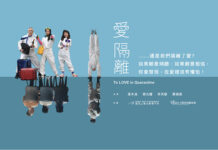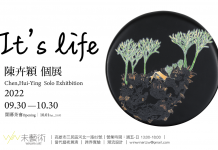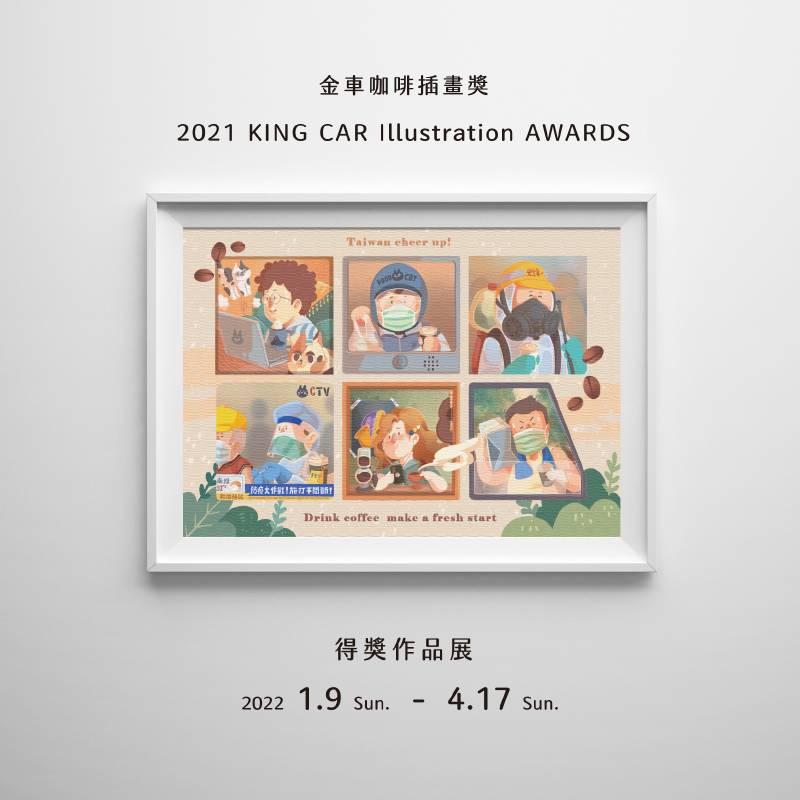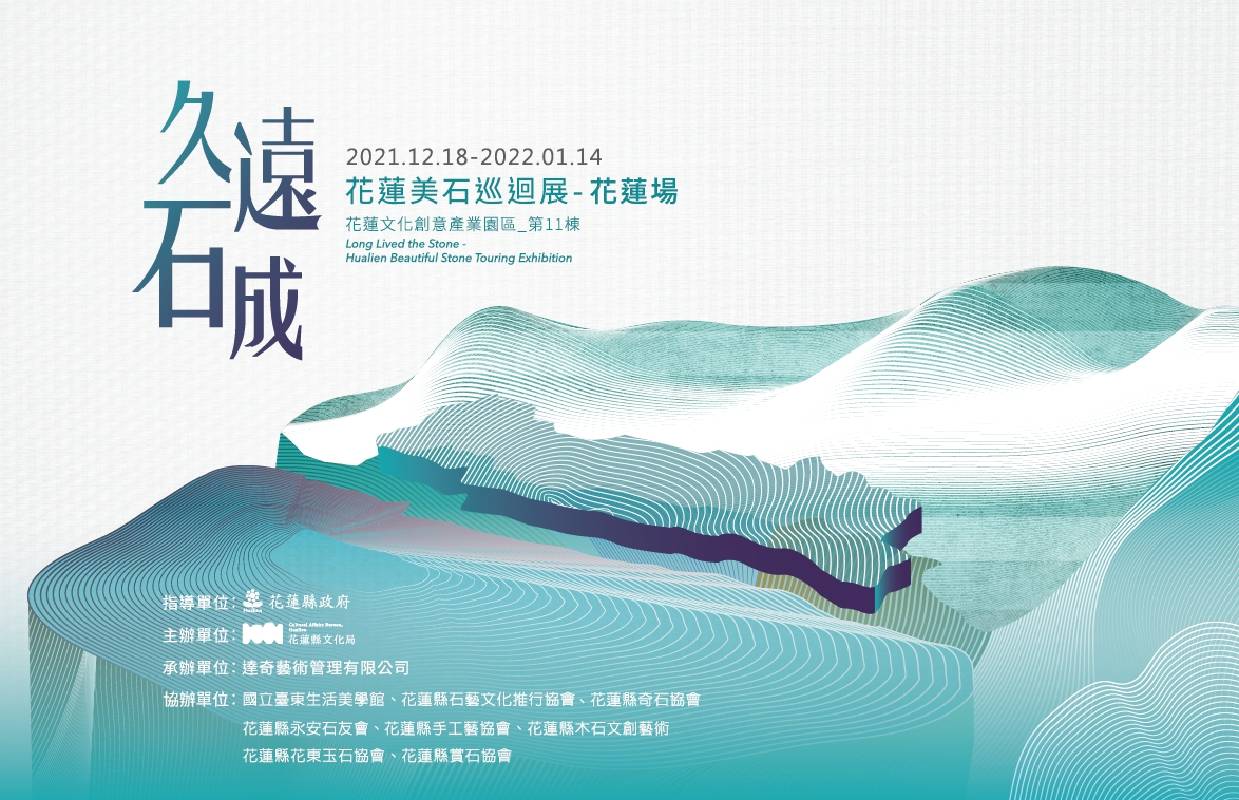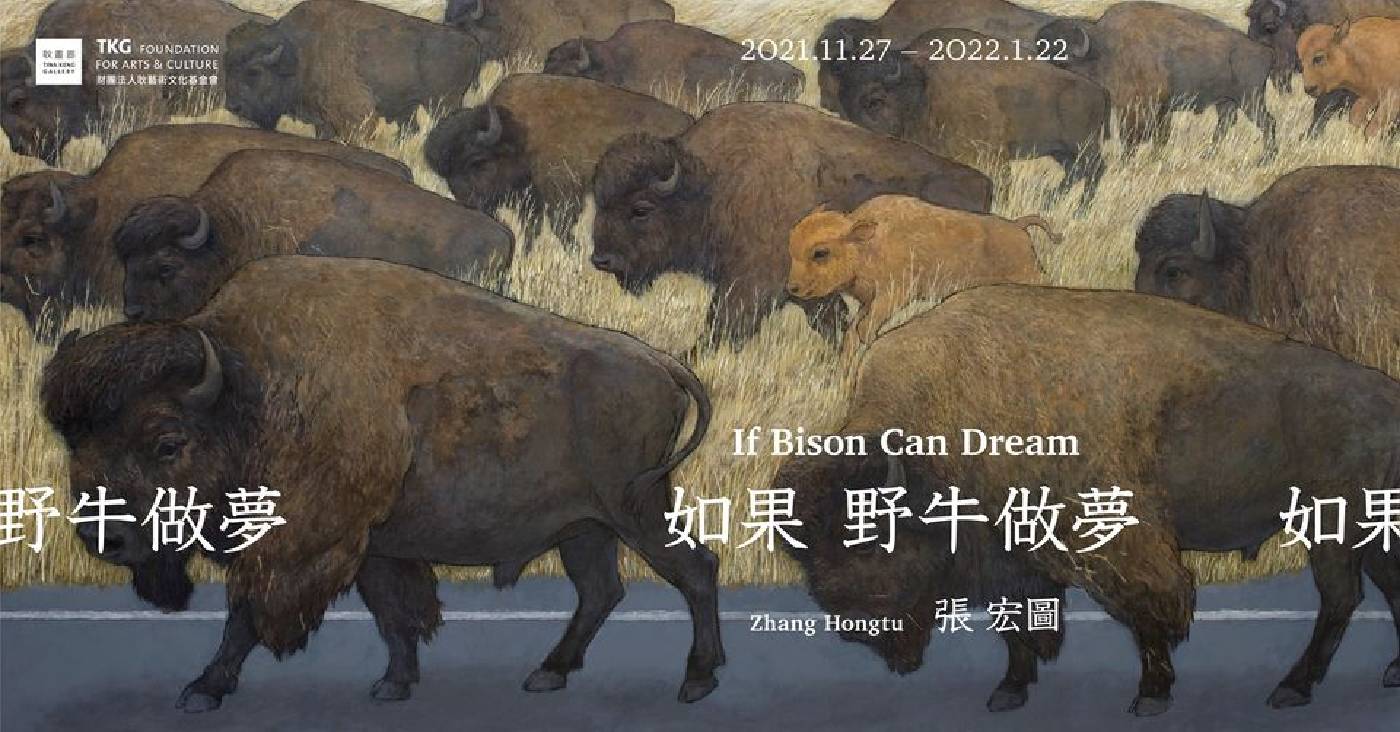
-
展期
日期:2021-11-27 ~ 2022-01-22
-
地點
台北市內湖區瑞光路548巷15號1樓
-
參展藝術家
張宏圖

「是投射嗎?有可能。
是幻覺?也許吧。
但,又或許,是代表其他的事物。」—— 肯特‧納本《對著野牛唱歌的女孩》
「梵谷/達摩」後四年養晦,耿畫廊與張宏圖攜手呈獻「如果野牛做夢」個展發表。在牛年尾聲舉辦一個關於「牛」的展覽,雖看似應景偶合,於張宏圖而言卻是他仿若野牛漫遊、遷徙的生命長途所給予的珍貴偶遇。
張宏圖作品理性而好奇,激烈而和諧,總能以沉穩、無懼的別緻角度將細膩情感抒於創作,他經歷中國文革、見證大時代震盪,並於1980年代出走原鄉,移居紐約。多年來張宏圖藉異地遷徙深探中西文化血緣,以解構偶像並鍛鍊出個人「混血」創作風格,他將中國古代山水與印象派、後印象派繪畫風格並置重作,主張觀念創造,後經「以造化為師;為今日山水傳神」為提問,將非相融性繪料(水墨與油)的層疊實驗拓深至對人文、自然環境變遷的終極關懷,依此形塑「山水今天」中漠然旁觀山海的猿猴、「梵谷/達摩」慈悲而堅定的大智慧達摩,以及如今「野牛漫步」的長期創作研究。
1962年,張宏圖在北京西郊動物園速寫,首次見到兩隻野牛,體型龐大、毛色棕黑,處在比其身軀大不了太多的狹窄空間,與動物園人造環境格格不入。速寫時分,他想若這些野牛生活在原始曠野,會是何景象。2018年,張宏圖在北美堪薩斯高草原再次「偶遇」美洲野牛,此景使他閃回56年前,在北京動物園初見野牛的觸動,現如今,這群在他記憶中溫順而龐然有力的動物,雖得以結伴成群來到艷陽藍天底下,擁有遼闊的空間、食不盡的青草,卻也僅能在欄柵中以身體遙想先祖立於原始曠野的記憶,遙距萬里遠的兩樣情境霎時間在張宏圖的記憶中連結,他望向草原上緩緩移動的野牛,野牛也望向他,他明確意識牠們是大地的一部分、來自自然,凝視的靜默彷彿製造了巨大的聲響。
回觀北美大陸歷史,早期印地安人以野牛為食,以其皮革保暖,仰仗野牛度過悠長萬年歲月,直至殖民者為工業鐵路直驅而入,以濫殺野牛為道,使原始社群無以生存而失去經濟自主,19世紀中美國華工的勞動血汗與「第一條縱貫大陸鐵路軌道」接通,亦與印地安人及野牛的命運重合,每塊枕木皆象徵著複數勞動者生命逝去的致意,張宏圖在《當您來到這幅畫前時,請注意不要忘記向野牛致意》中亦展示對野牛的愛敬,他將《受胎告知》中的主角抽換為野牛,賦予其神格的隱喻。作為力大無比且體型巨大的生物,北美野牛實為美洲哺乳動物的瀕危代表物種,19世紀末曾僅剩300多頭、現存則約36萬頭。圈養的保護形式成為必要,當代社會的權柄及其對環境的開發卻並無休止,野牛若跨越保護區仍將遭受獵捕的命運,一如張宏圖自述:「野牛如果會做夢,牠們可能每天都夢到祖先們生活的曠野;當我在Covid-19疫情期間創作時,我不僅與他人隔離,也像野牛一樣,被隔離於真正的荒野和自由之外,唯一能做的是藉助藝術來想像。」—— 過去事實與彼時狀態皆在本系列中展現,亦是近年你我因現實緩步、遷徙、停留、與環境共存的回望反思。
張宏圖於本系列研創期間多次參訪堪薩斯,造像千張野牛與草原紀錄、並於當地採石創作,觀者造訪展場將得以由「野牛漫步」系列繪畫、雕塑及藝術家未曾發表之數件「牛系列」早期創作、珍貴手稿圖錄、檔案文件等內容,細品張宏圖何以繪牛、繪自然、繪人類世,表達他身處社會/生態/心理環境的跨幅轉變。56年對他者而言或許是時光前行量化後的重量,對藝術家自身卻是時空瞬變、化無的震撼。除前述「牛相關」創作外,畫廊亦於展場特別規劃紀錄片放映空間,呈現導演方昕拍攝張宏圖創作「野牛漫步」系列首幅作品《野牛瑞鶴圖,宋徽宗後九百零七年》間的前後獨白,深入了解藝術家的藝術史觀點、出走心境與新系列作品之人文底蘊。
–
▋張宏圖 ▋
1943年生於中國甘肅省,他的藝術養成始於中國,然經中國文革與文化大躍進等波折後,在1980年代離開中國、定居紐約。重要展歷包括:「張宏圖:如果野牛做夢」(耿畫廊,台北,台灣,2021);紐約弗里兹藝博會(紐約,美國,2021、2019);「文化混血大師 張宏圖」(瑪莉安娜.奇斯勒.碧曲美術館,堪薩斯州立大學,美國,2018);「梵谷/達摩 – 張宏圖個展」(耿畫廊,台北,台灣,2018);「張宏圖:梵谷/達摩」(查爾斯.尚恩圖書館,康乃狄克學院,美國,2018);「1989後的中國:世界劇場」(古根漢美術館,紐約,美國,2017);「張宏圖」(皇后美術館,紐約,美國,2015);「啟程:張宏圖1985-2004作品選」(耿畫廊,台北,台灣,2015);「當代藝術中的畢卡索」(當代藝術中心,堤壩之門,漢堡,德國,2015);「中國:鏡花水月」(大都會美術館,紐約,美國,2015);「人類簡史」(以色列美術館,耶路撒冷,以色列,2015);「後畢卡索:當代反映」(畢卡索美術館,巴塞隆納,西班牙,2014)。其作品廣為重要美術館及私人收藏,如北京中國美術館、廣東美術館、紐約布朗克斯美術館、普林斯頓大學美術館及阿布達比古根漢美術館等。
–
► If Bison Can Dream: Zhang Hongtu Solo Exhibition
Exhibition Dates │ 11.27.2021 – 01.22.2022
Reception │ 11.27.2021 (Sat.) 4:30 p.m.
Venue │ Tina Keng Gallery (1F, No. 15, Ln. 548, Ruiguang Rd., Neihu Dist., Taipei, Taiwan)
Projections? Maybe.
Fantasies? Possibly.
But, perhaps, something else. —— The Girl Who Sang to the Buffalo, Kent Nerburn
Four years after his previous exhibition Van Gogh/Bodhidharma, Tina Keng Gallery is pleased to present Zhang Hongtu's latest body of work in his solo exhibition If Bison Can Dream. As the Year of the Ox comes to an end, this exhibition about the ox is not the result of an intentional thematic alignment, or a mere coincidence. Throughout this exhibition, the bison symbolizes the significance of chance encounters during Zhang's journey of migrating and roaming over great distances.
Zhang's work is rational yet curious, fierce yet harmonious. He expresses a sense of calm defiance with a fearlessness that defines his aesthetic perspective. After living through the Chinese Cultural Revolution and suffering through the turmoil of the era, Zhang left his home country and moved to New York in the 1980s. Over the years, Zhang has explored a deep cultural lineage between the East and West as he migrated between old and new terrains. The artist channels his personal experiences into a unique hybrid style, often deconstructing, reinterpreting, and juxtaposing familiar tropes and icons —— such as traditional Chinese landscape paintings and Impressionist/Post-Impressionist styles. As an advocate for continual aesthetic experimentation, Zhang centers his practice on a philosophy of “taking good fortune as a teacher” and “embodying the spirit of the landscape.” By challenging established conventions and conflating elements that are typically kept separate (such as ink and oil paint), Zhang forges a new aesthetic vocabulary that he uses to express his ultimate concerns for humanity and the natural ecosystem. Within this conceptual framework, he painted the monkeys who wander indifferently through desolate landscapes in his “Shanshui Today” series, the wise and compassionate Zen Bodhidharma in his “Van Gogh/Bodhidharma” series, as well as his current “Bison Roaming” series.
Zhang was sketching animals at the Beijing Zoo in 1962 when he encountered the bison for the first time. He saw two large bison with brown-black coats enclosed in a space not much larger than their bodies, and their confinement in the man-made environment seemed entirely unnatural. As he sketched the animals, he imagined what it would be like to see them living in their natural, wild habitat. In 2018, Zhang's imagination came to life during his first chance encounter with American bison roaming the tallgrass prairies of Kansas. The idyllic scene induced a flashback to when he first laid eyes upon a bison at the Beijing Zoo, and that chance encounter sparked an instant connection between the two moments in Zhang's memory, spanning 56 years and thousands of miles. Zhang's vision of the animal confined in custody was then replaced by the image of the bison roaming under sunny blue skies and endless plains, with the spirits of their ancestors looking over them from beyond the mountains. As he watched the bison slowly marching across the grassland, one bison returned his gaze. The connection he felt while looking into its eyes made Zhang realize that they were both of the same earth and of the same nature, and the powerful silence they shared in that intimate moment produced a resounding echo.
Throughout the history of North America, the Native Americans relied on bison for survival, using their meat for sustenance and their hides to keep warm for tens of thousands of years. When the colonists invaded Native territories as they built the Transcontinental Railroad, their indiscriminate killing of bison robbed indigenous communities of their economic autonomy and their means of survival. The blood and sweat of Chinese immigrant workers in the 19th century are inextricably linked to those railroad tracks, and their fates were also linked to those of the Native Americans and the bison. Seen as such, each wooden railroad tie represents a life lost, human and animal, in the process of early American industrialization.
Zhang pays respect to the great beast with a gentle command to the viewer in his work When You Come Before the Image of the Bison Take Care That You Do Not Neglect To Say an Ave. The artist even depicts the bison as the protagonist of an annunciation scene, consecrating the animal with a sense of godhood. Only roughly 300 bison remained at the end of the 19th century, and while there are around 360,000 bison alive today, they are only able to survive under protective captivity in wildlife sanctuaries. Despite being a large and extremely powerful creature, the American bison remains an endangered species. If a bison were to escape its sanctuary, it would certainly suffer the fate of being hunted. In an artist statement, Zhang reflects: “If bison can dream, they must dream of the wild plains where their ancestors roamed every day. While working on my art during the Covid-19 epidemic, I was not only isolated from others; like the bison, I found myself isolated from true wilderness and all of its freedom. The only thing I could do was imagine it through my art.” This series encapsulates both remnants of history and the gradual passage of time. Through this exhibition, Zhang presents his reflections on the reality of slowing down, migrating, remaining stationary, and coexisting with the environment over the years.
Throughout the making of this series, Zhang visited Kansas several times, and took thousands of photos of bison and the tallgrass prairies. He also carved reliefs into stones sourced from a local quarry. On view alongside the paintings and sculptures of his latest “Bison Roaming” series is a compilation of unpublished early works, precious manuscripts, and archival documents from his early “Ox” series. By viewing these works together, the viewer will discover the disruptions and transformations of Zhang's social, environmental, and psychological journeys through his depictions of bison, nature, and the Anthropocene. In addition to the aforementioned works, the gallery will be screening an exclusive documentary by director Fang Xin presenting Zhang's monologues from before and after his creation of Bison and Cranes, After the Emperor Huizong of Song 907 Years Later, the first work in the “Bison Roaming” series. In the documentary, Zhang Hongtu shares his views on art history, his journey leaving home, and the cultural foundations of his new series.
–
▋Zhang Hongtu ▋
Born in Gansu Province, China in 1943, Zhang Hongtu's artistic cultivation began in China, but after enduring the upheavals of the Great Leap Forward andthe Cultural Revolution, he left China in the 1980s to settle in New York. He has exhibited internationally, including Zhang Hongtu: If Bison Can Dream, Tina Keng Gallery, Taipei, Taiwan (2021); Frieze New York, New York, U.S. (2021 and 2019); Culture Mixmaster Zhang Hongtu, Marianna Kistler Beach Museum of Art, Kansas State University, U.S. (2018); Zhang Hongtu: Van Gogh/Bodhidharma, Tina Keng Gallery, Taipei, Taiwan (2018); Zhang Hongtu: Van Gogh/Bodhidharma, Charles E. Shain Library, Connecticut College, U.S. (2018); Art and China After 1989: Theater of the World, Solomon R. Guggenheim Museum, New York, U.S. (2017); Zhang Hongtu, Queens Museum, New York, U.S. (2015); The Journey Begins: Zhang Hongtu 1985-2004, Tina Keng Gallery, Taipei, Taiwan (2015); Picasso in Contemporary Art, The Hall for Contemporary Art, Deichtorhallen, Hamburg, Germany (2015); China: Through the Looking Glass, Metropolitan Museum of Art, New York, U.S. (2015); A Brief History of Humankind, Israel Museum, Jerusalem, Israel (2015); and Post-Picasso: Contemporary Reactions, Museu Picasso, Barcelona, Spain (2014). Zhang's work is housed in renowned institutions and private collections, such as the National Museum of Art, Beijing, China; Guangzhou Art Museum, Guangzhou, China; Bronx Museum of the Arts, NY, U.S.; Princeton University Art Museum, NJ, U.S.; Guggenheim Abu Dhabi, among many others.
內文引用:耿畫廊 Tina Keng Gallery
圖片來源:耿畫廊 Tina Keng Gallery
文章更新2021/12/22


